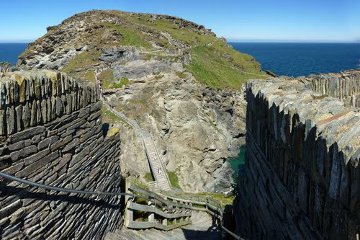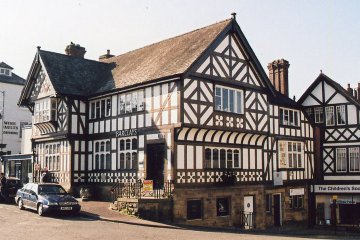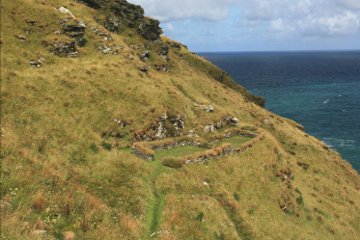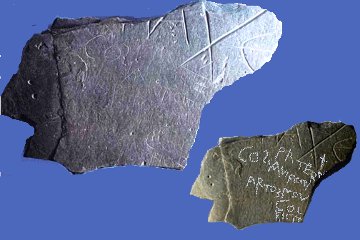Arthur the Bear
| Tintagel | 50 40 07.75N 04 45 43.35W | The outline of the castle, which encompasses the whole of the almost-island, can be clearly seen. |
| Rhuthun | 53 06 51.75N 03 18 38.72W | The coordinates should be directly over Hywel's Stone (Maen Hywel) in Rhuthun town centre. |
We have often commented upon the caprices of the goddess Luck, who seems to delight in arranging it that on the last day of an archaeological excavation something will be found of such interest and importance that the whole expedition has to be unpacked and delayed in order to deal with the object. This happens sufficiently frequently that it might be an idea for expedition leaders to announce the date of their departure a week or two in advance - and then leave early, thus frustrating the goddess in her malicious machinations!

| |
| Visitors to the island part of Tintagel Castle have to go down these stairs up climb up the other side. |
For the last eight seasons, a team from the University of Glasgow has been digging at the ancient castle of Tintagel, which is partly built on an eroded headland on the north Cornish coast. In order to reach the castle visitors have to climb down a fairly steep path into the gap where the neck of land that joins the headland to the mainland has been almost eaten away by the sea. In fact, there is a small wooden bridge to carry tourists over the most eroded portion, after which there is a steep climb up onto the headland where the ruins of the castle stand.
Settlement on this highly defensible site took place very early on: down on one grassy shelf are the remains of a Celtic "clas" or monastery and the fortifications may go back to well before the Christian era. In fact, it was to establish the antiquity and history of the site that Professor Christopher Morris and his team were working at the castle.
No doubt their work was hampered by the constant stream of tourists who come to Tintagel, which is one of the great tourist draws of Cornwall. Its fame lies not in its beautiful location (other castles are even more dramatically sited) nor in its magnificent fortifications (for very little of the castle, built by Earl Richard of Cornwall in the 13th century, survives) but in one single fact: according to Sir Thomas Malory, author of Le Morte D'Arthur, the famous king of the Round Table was born here and often held court here.
No visitor to the castle can possibly escape reference to King Arthur. The village, half a mile from the castle, is crammed with tourist shops offering dubious coats of chivalric arms, swords in stones (in various sizes), round tables by the dozen, model figures of all the famous knights and Excaliburgers in the fast food outlets. So far, however, all the hullaballoo has been nothing more than tourist hype, for hard facts about King Arthur are very hard to come by.

| |
| Hywel's Stone can be seen in the angle of the building in Rhuthun town centre just behind the blue car. |
In part that may be Arthur's own fault. At Rhuthun, in north Wales, not far from where I live, there is a rough stone in the town square. According to a local tradition, Arthur and another young man, by the name of Hywel, were rivals for the hand of the beautiful Guinevere. When it seemed that Hywel's suit might be successful, Arthur and some of his friends waylaid the young man and hacked his head off on the stone.
Although the murder ensured that Arthur got Guinevere (and thereby his death many years later when she was unfaithful to him with Lancelot), it also meant that Arthur promptly dropped out of the history books, for Hywel's brother, Gildas, is our principal source for the history of the troubled times after the Romans left Britain! In revenge for his brother's murder, Gildas never mentions Arthur.
For some time historians have suspected that, despite the accretions of legend, there was a real historical Arthur with a war band who fought against the invading Saxons and, for a time at least, held them at bay. Probably the romantic knights were simply the heavy cavalry inherited from the Romans, armoured and disciplined, with whose aid Arthur was successful against the Saxon infantry.
Arthur's greatest victory seems to have been at Mount Badon, in which his out-numbered riders charged into a Saxon host and scattered them, then used their horses to hunt down the fleeing infantrymen and slaughter them. (Julius Caesar describes half a dozen similar encounters in his Gallic Wars.) Unfortunately, no one knows where Mount Badon is, and locations that have been suggested range from southern England to the borders of Scotland.
It would seem that Arthur was killed in a battle at Camlan, in or around AD 510, but once again no one can be sure where this place is and uncertainty also surrounds the location of Camelot, the capital from which Arthur's knights rode out to rally the Britons and defeat the enemy.
So far the only archaeological evidence for Arthur's existence is the claim made by the medieval monks of Glastonbury Abbey. Shortly before a royal visit they announced that in the course of repairs to the foundations of their abbey they had discovered the bones of a man and a woman, both neatly coffined. On the man's coffin was the inscription, "Here lies Arthur, the Once and Future King".
The claim attracted a good deal of attention at the time and, as the monks had intended, was suitably rewarded by the king. The remains were reburied in a central position in the abbey church and suitably honoured by the stream of pilgrims, whether rich or poor. Alas, whatever it was that the monks discovered, it vanished when Henry VIII destroyed the monasteries and looted their riches.

| |
| According to information I received at Tintagel, this is the location of the rubbish dump where the "Arthur Stone" was found. |
On July 4 the 1998 season of excavations at Tintagel was drawing to a close, with only a few days to go. The team was working on the east side of the peninsula where some previous excavations had been carried out in the 1930s, but the square where they were digging had not been disturbed at any time since the sixth or seventh centuries AD.
Like the most profitable sites Professor Morris was excavating a rubbish dump where shards of pottery from wine and oil amphorae had been dumped. The presence of these amphorae, most of which came from France and the Mediterranean, proved that the settlement at Tintagel had been both wealthy and important, twin factors usually associated with government of some sort.
Among the potshards was a broken piece of greenish-grey stone 13" x 8". The digger turned it over and reached for the bucket in which all the loose soil and archaeological rubbish was deposited, but then paused. On the underneath of the stone were scratched marks that could be writing. The digger brushed at the dirt and then yelled for the site supervisor: it was writing.

| |
| The "Arthur Stone" found at Tintagel. (Inset: a copy with the inscription highlighted in chalk.) |
Deeply cut into the stone were the letters "..AXE.." There were the remains of other letters where the stone was broken, but it is impossible to be sure what they were intended to represent. Below these letters, however, others had been scratched on the stone and these made up a complete phrase: Pater Coliavi ficit Artognov . Roughly translated, this means, "Artognou, the father of Coll's son, made this".
Much, of course, depends on how the name "Artognou" should be pronounced. Geoffrey Wainwright, chief archaeologist with English Heritage, suggests that the pronunciation was probably something like "Arthnou" which is close enough to "Arthur" to satisfy him that here, at last, we have a real relic of the mysterious king.
Professor Morris, who is sceptical, explains that "it was originaly part of a building which fell down not long after it was built and was re-used as a drain cover. ... The inscription is the first evidence we have that the skills of reading and writing were handed down in a non-religious context and that Arthnou was a person of considerable status. ... Because of the script and the archaeological context in which it was found, we can be sure that it is an early sixth century object, but I don't think this necessarily tells us anything about Arthur."
Geoffrey Wainwright is less cautious. "Tintagel has presented us with evidence of a court of the Arthurian period, with stone buildings, high status finds and the name of a person - Arthnou. Arthnou was here; that is his name on a piece of stone. This is where myth meets history. This is the find of a lifetime!"
As always, there is no argument about what has been found: the dispute is over what it means. There is no doubt, however, that the diggers next season will be examining every piece of stone and broken pottery with eagle-eyed vigilance, looking for the next inscription and the next link in the chain that joins myth and history.





